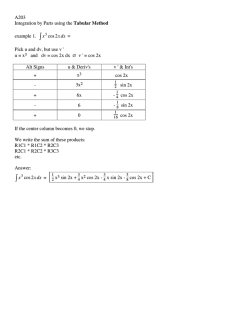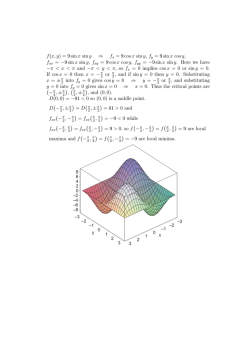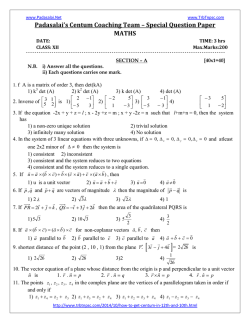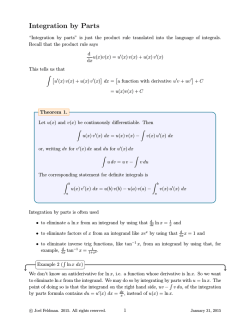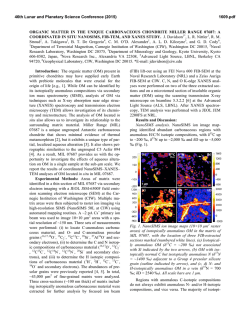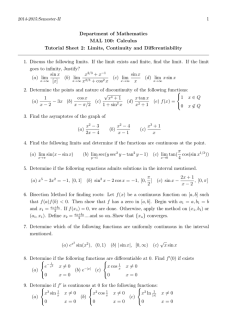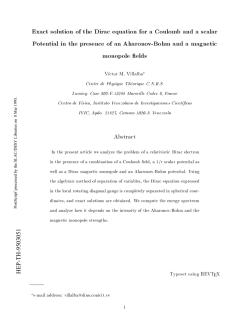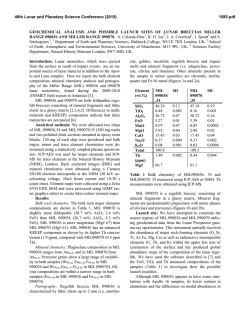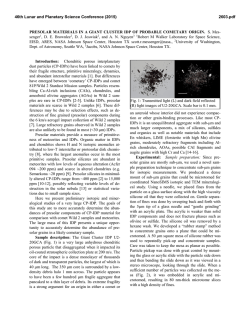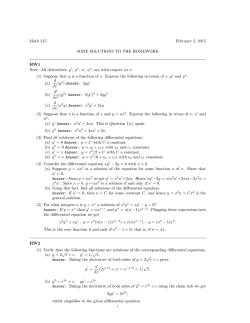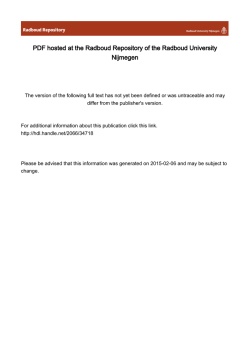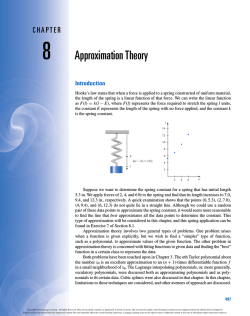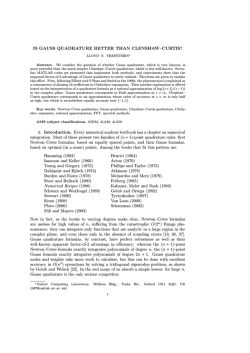
2097
46th Lunar and Planetary Science Conference (2015) 2097.pdf A SEARCH FOR COSMIC SYMPLECTITE IN THE ACFER 094 AND MILLER RANGE 07687 METEORITES. Larry R. Nittler1,*, Jemma Davidson1, Nan Liu1, Conel M. O’D. Alexander1, and Rhonda M. Stroud2, 1Department of Terrestrial Magnetism, Carnegie Institution of Washington, Washington DC 20015. 2Naval Research Laboratory, Washington DC 20375. *E-mail: [email protected] Introduction: The origin of non-mass-dependent O-isotopic variations across the Solar System is a major unsolved problem in planetary science. With the exception of some of the earliest refractory components of chondritic meteorites, essentially all sampled planetary materials are enriched in 17O and 18 O, relative to 16O and the Sun [1]. Bulk meteoritic Oisotope data can be broadly explained by invoking the presence of an 16O-poor water reservoir in the solar nebula [2], possibly the result of self-shielding during photodissociation of CO [3]. The best evidence for the existence of such a reservoir is “cosmic symplectite” (COS), found in the very primitive ungrouped carbonaceous chondrite Acfer 094 [4, 5]. COS was identified on the basis of its very unusual O-isotopic composition (δ17O=δ18O>+150‰) and found to consist of aggregates of nanocrystalline Fe sulfides and magnetite. It is interpreted as being a product of nebular alteration of pre-existing sulfide by 16O-poor water vapor. COS has not been reported in any meteorite besides Acfer 094, although a mineralogically similar material with terrestrial-like O isotopes was recently reported in a sample from comet Wild 2 [6]. Material isotopically similar to but chemically distinct from COS was also recently reported in an interplanetary dust particle [7]. Miller Range (MIL) 07687 is a very primitive carbonaceous chondrite that bears some similarity to Acfer 094 [8, 9]. Although it shows localized regions of partial aqueous alteration [8], it has high abundances of presolar grains and isotopically anomalous organic matter [10]. Here we report chemical and isotopic searches for COS in both MIL 07687 and Acfer 094. We have confirmed the existence of COS in Acfer 094 and identified an unusual 16O-poor object in MIL 07687 that may be related to COS. Methods: We used a JEOL 6500F FE-SEM equipped with an Oxford Instruments EDS system to produce element maps of polished thin sections of Acfer 094 and MIL 07687, with a pixel size of 370 nm. Total areas of slightly more than 5 × 105 µm2 were mapped in each meteorite. Maps were searched for regions with low counts of Si x-rays and high counts of Fe, S and O x-rays; these were considered COS candidates [11]. For MIL 07687, we also re-examined NanoSIMS O-isotopic images acquired previously for a search for presolar grains [10]. Images were rebinned to ~1µm resolution to improve statistical precision and automatically searched for regions with O-isotopic signatures similar to COS. Following identification by either EDS mapping or re-analysis of prior SIMS images, COS candidate grains were (re-) measured for their O-isotopic compositions with the Carnegie NanoSIMS 50L ion microprobe. The data were corrected for quasi-simultaneous arrival [12] effects based on measurements of magnetite grains in the Dominion Range 08006 CO3 chondrite. O isotopic data for candidate grains were normalized to surrounding matrix, assumed to have δ17O= δ18O=0. Results and Discussion: We measured O isotopes in four COS candidate grains in Acfer 094 and seven in MIL 07687 identified by SEM-EDS mapping. Of these, only the largest candidate in Acfer 094 (≈20 × 8 µm, Fig. 1) was found to have an anomalous O isotope signature (Fig. 2). This grain has a chemical composition identical to that previously reported for Acfer 094 COS as well as similar O isotopic ratios; we ascribe our slightly lower measured δ17O value to an instrumental artifact. None of the other candidates (mostly <5µm) identified in either meteorite had anomalous O isotopes. The single large grain gives an abundance of COS in Acfer 094 of 230 ppm, comparable to prior estimates [4, 11]. Figure 1. Backscattered electron (top) and RGB (Fe, S, O) composite x-ray (bottom) maps of 16O-poor COS in Acfer 094. 46th Lunar and Planetary Science Conference (2015) Of two COS candidate regions identified in previous NanoSIMS data of MIL 07687, one was confirmed to have a mass-independent O-isotope anomaly (δ17O≈δ18O≈34‰, Fig. 2). Interestingly, this material is chemically distinct from COS; NanoSIMS and SEM-EDS measurements (Fig. 3) indicate that it is rich in O, C, Fe, and Ca, and poor in Si and S. It is likely a fine-grained aggregate of Ca carbonate and either Fe carbonate and/or Fe oxide. Planned FIB extraction and TEM analysis will better elucidate the nature of this phase. Figure 2. O 3-isotope plot of Solar System materials (2-σ errors). Planetary composition lies on mixing line between 16O-rich solar composition (inferred from solar wind [SW, 1]) and 16O-poor COS. Carbonate-rich object in MIL 07687 is also 16O-poor, but less so than Acfer 094 COS. Previous COS data from [4]; TFL= terrestrial fractionation line. Figure 3. SEM and NanoSIMS images of 16O-poor material in MIL 07687. A) Secondary electron image; yellow ellipses indicate location of O-anomalous material. B) NanoSIMS 16O- ion image; anomalous material has a relatively high secondary 16O- ion yield. c) RGB (C, O, Fe) composite x-ray map; O-anomalous material is rich in these elements. d) NanoSIMS 56Fe16O- ion image. 2097.pdf To our knowledge, this work is the first independent confirmation of the presence of Oanomalous COS in Acfer 094. The COS candidates that did not show anomalous O isotopic compositions typically appeared less homogeneous in SEM images and x-ray maps than the anomalous COS grain. They may be COS grains that were originally anomalous but have been subsequently altered in the parent body [11]. Alternatively, they may have formed by a similar process to COS, but with an altering fluid of a more planetary-like O-isotopic composition, e.g., 16O-poor COS may be nebular in origin, whereas isotopically normal COS may be either asteroidal or nebular, but if the latter, from a region and/or time when the water was less isotopically anomalous. It is unclear whether the O-anomalous material identified in MIL 07687 is related to the COS grains found in Acfer 094. Since MIL 07687 may be genetically related to Acfer 094 but has experienced more extensive parent-body aqueous alteration, originally present COS grains may have been altered or decomposed in this meteorite, and perhaps the anomalous carbonate aggregate preserves a snapshot of this process. If so, , the parent-body fluids that precipitated that carbonate also would have partially equilibrated the O isotopes towards a more planetarylike composition. Alternatively, the 16O-poor carbonate assemblage may have formed independently from COS, either in the nebula or on the parent body, but from a related 16O-poor water reservoir. We will continue to search both primitive meteorites for 16Opoor materials to better understand the origin of O isotopic variations in the Solar System. References: [1] McKeegan K. D., et al. (2011) Science, 332, 1528-1532. [2] Clayton R. N., Oxygen Isotopes in Meteorites, in: H.D.H.K. Turekian (Ed.), Treatise on Geochemistry 1, Pergamon, Oxford, 2003, pp. 129-142. [3] Clayton R. N. (2002) Nature, 415, 860-861. [4] Sakamoto N., et al. (2007) Science, 317, 231-233. [5] Seto Y., et al. (2008) Geochimica et Cosmochimica Acta, 72, 2723-2734. [6] Nguyen A. N., et al. (2014) 77th Annual Meeting of the Meteoritical Society, Abstract #5388. [7] Starkey N. A., et al. (2014) Geochimica et Cosmochimica Acta, 142, 115131. [8] Brearley A. J. (2012) Lunar and Planetary Science Conference, 43, Abstract #1233. [9] Davidson J., et al. (2014) Lunar and Planetary Science Conference, 45, Abstract #1384. [10] Davidson J., et al. (2014) Lunar and Planetary Science Conference, 45, Abstract #1376. [11] Abe K., et al. (2011) LPI Contributions, 1639, Abstract #9043. [12] Slodzian G., et al. (2004) Applied Surface Science, 231–232, 874877.
© Copyright 2026

